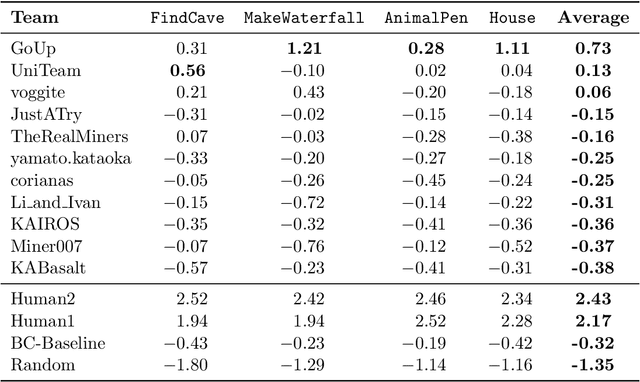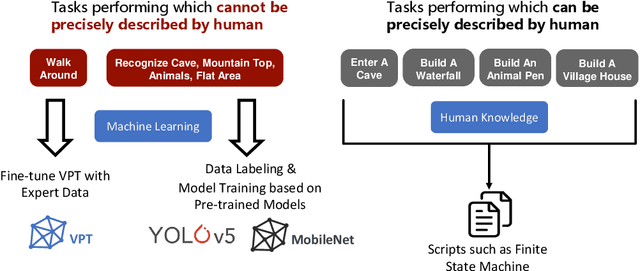Robert Klassert
Towards Solving Fuzzy Tasks with Human Feedback: A Retrospective of the MineRL BASALT 2022 Competition
Mar 23, 2023



Abstract:To facilitate research in the direction of fine-tuning foundation models from human feedback, we held the MineRL BASALT Competition on Fine-Tuning from Human Feedback at NeurIPS 2022. The BASALT challenge asks teams to compete to develop algorithms to solve tasks with hard-to-specify reward functions in Minecraft. Through this competition, we aimed to promote the development of algorithms that use human feedback as channels to learn the desired behavior. We describe the competition and provide an overview of the top solutions. We conclude by discussing the impact of the competition and future directions for improvement.
Improving performance in multi-objective decision-making in Bottles environments with soft maximin approaches
Aug 11, 2022



Abstract:Balancing multiple competing and conflicting objectives is an essential task for any artificial intelligence tasked with satisfying human values or preferences. Conflict arises both from misalignment between individuals with competing values, but also between conflicting value systems held by a single human. Starting with principle of loss-aversion, we designed a set of soft maximin function approaches to multi-objective decision-making. Bench-marking these functions in a set of previously-developed environments, we found that one new approach in particular, 'split-function exp-log loss aversion' (SFELLA), learns faster than the state of the art thresholded alignment objective method (Vamplew et al, 2021) on three of four tasks it was tested on, and achieved the same optimal performance after learning. SFELLA also showed relative robustness improvements against changes in objective scale, which may highlight an advantage dealing with distribution shifts in the environment dynamics. Due to publishing rules, further work could not be presented in the preprint, but in the final published version, we will further compare SFELLA to the multi-objective reward exponentials (MORE) approach (Rolf, 2020), demonstrating that SFELLA performs similarly to MORE in a simple previously-described foraging task, but in a modified foraging environment with a new resource that was not depleted as the agent worked, SFELLA collected more of the new resource with very little cost incurred in terms of the old resource. Overall, we found SFELLA useful for avoiding problems that sometimes occur with a thresholded approach, and more reward-responsive than MORE while retaining its conservative, loss-averse incentive structure.
Variational learning of quantum ground states on spiking neuromorphic hardware
Oct 01, 2021



Abstract:We train a neuromorphic hardware chip to approximate the ground states of quantum spin models by variational energy minimization. Compared to variational artificial neural networks using Markov chain Monte Carlo for sample generation, this approach has the advantage that the neuromorphic device generates samples in a fast and inherently parallel fashion. We develop a training algorithm and apply it to the transverse field Ising model, showing good performance at moderate system sizes ($N\leq 10$). A systematic hyperparameter study shows that scalability to larger system sizes mainly depends on sample quality which is limited by parameter drifts on the analog neuromorphic chip. The learning performance shows a threshold behavior as a function of the number of variational parameters of the ansatz, with approximately $50$ hidden neurons being sufficient for representing critical ground states up to $N=10$. The 6+1-bit resolution of the network parameters does not limit the reachable approximation quality in the current setup. Our work provides an important step towards harnessing the capabilities of neuromorphic hardware for tackling the curse of dimensionality in quantum many-body problems.
 Add to Chrome
Add to Chrome Add to Firefox
Add to Firefox Add to Edge
Add to Edge